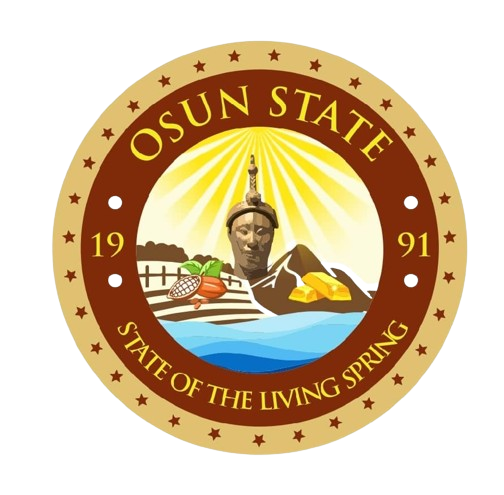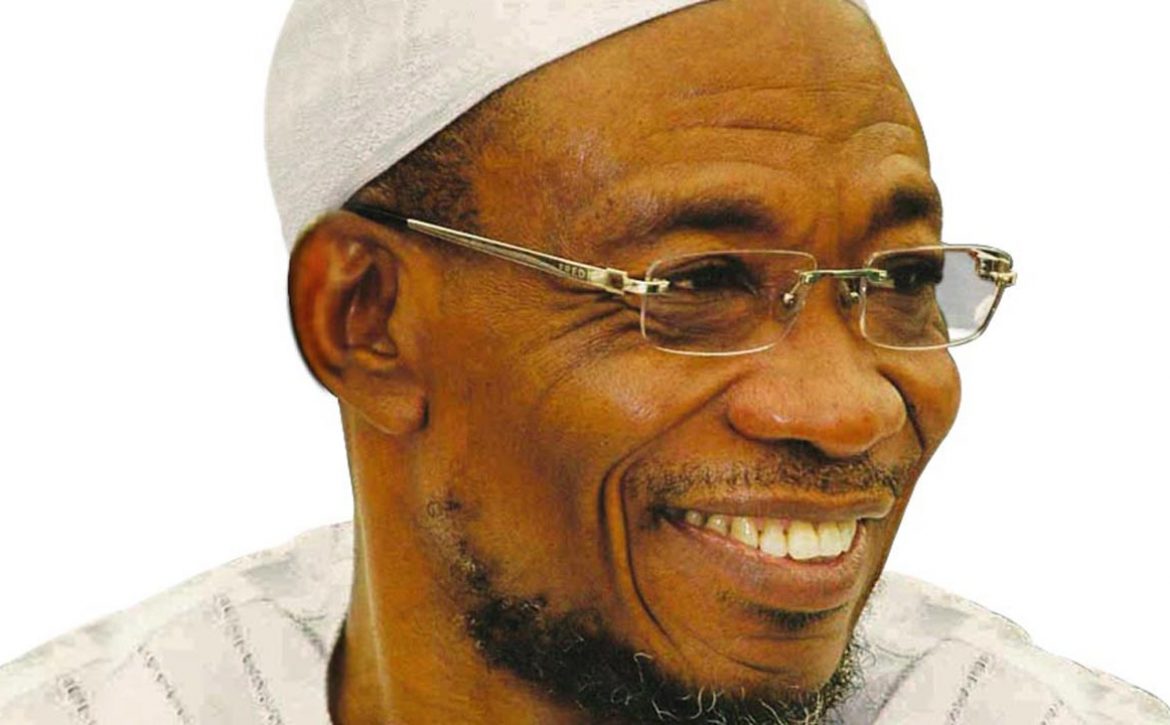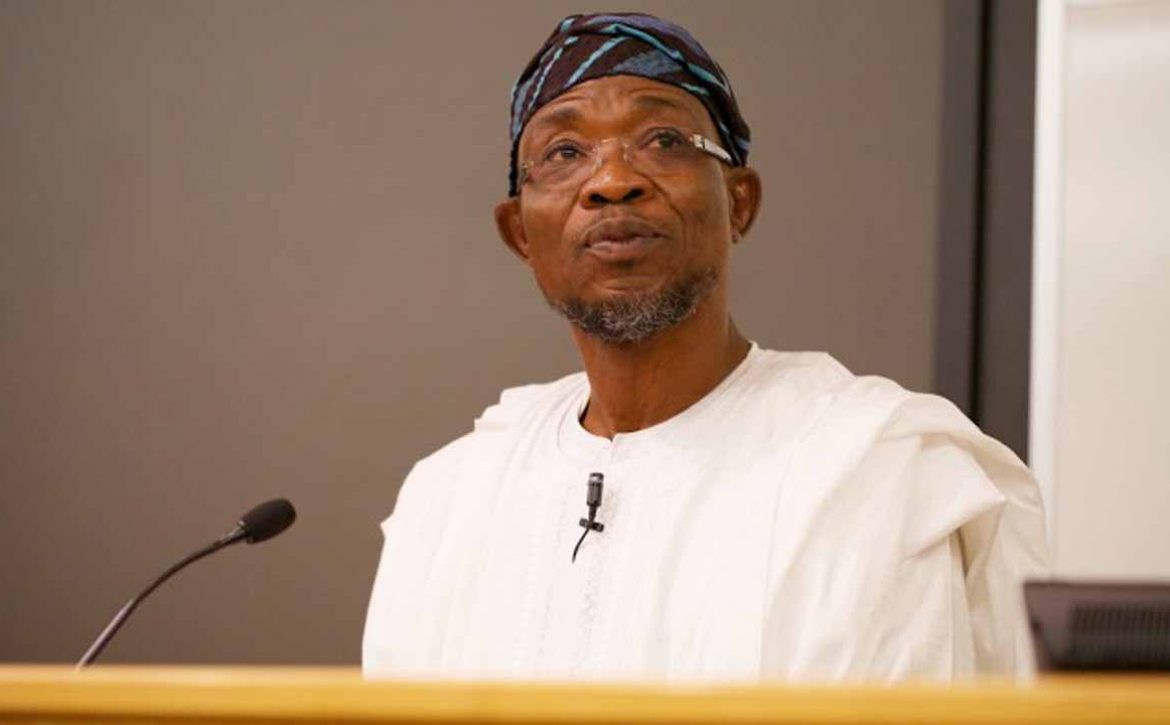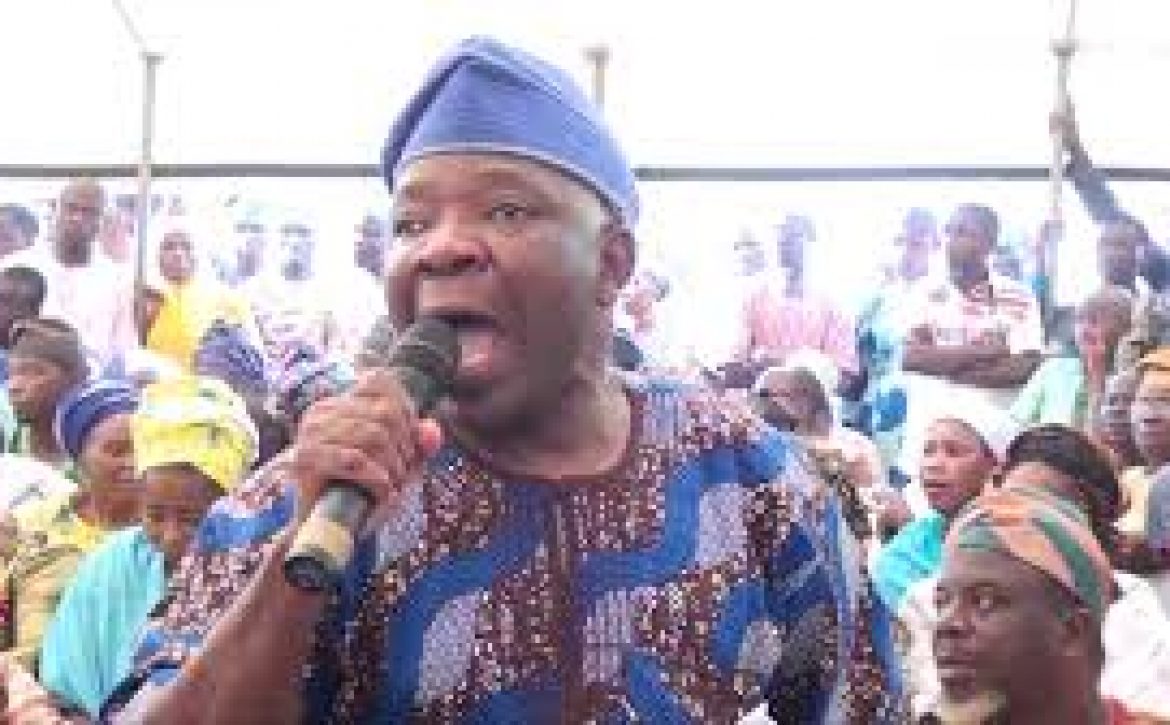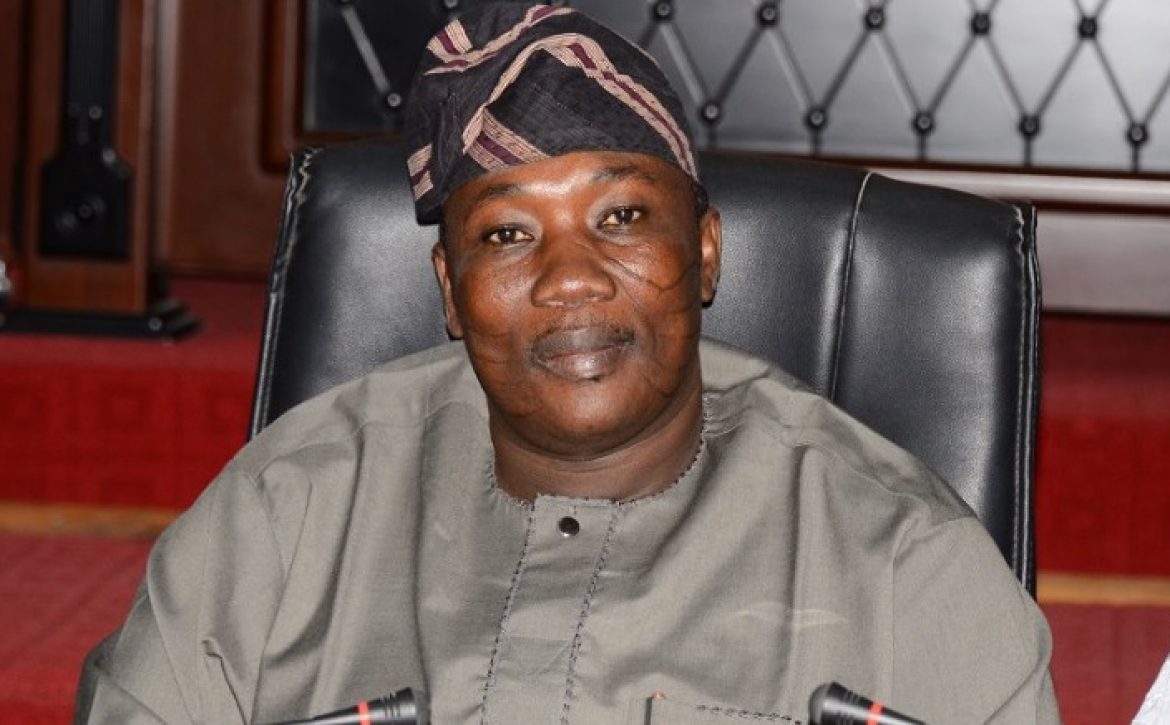“We have been asked to buy textbooks so as to prepare for the coming Senior WAEC but most of us have not been able to do that because of unavailability of money. Many of us cannot afford the textbooks and have been wondering how to pass the fast approaching exams.”
These were the words of Adeleke Busayo, a final year student of Adventist Government High School in Ede, Osun State as she received her “Opon Imo” tablet of knowledge provided for her free by the State Government of Osun under Ogbeni Rauf Aregbesola.

In a similar vein, the Head Girl of the school, Oluwatuye Mary buttressed what Busayo said.
She stated that most of the students have not been able to afford the needed textbooks for their coming exams, adding that that State Government has lifted an overweighting burden through the Opon Imo project.
“I feel so excited, we have been patiently waiting for the Opon Imo since the first day our principal told us about it. I am so happy to get the Opon Imo finally because we have been told to buy textbooks but not all could afford them. Now that the Opon Imo is here, embedded with several textbooks and past questions, the burden of having to buy textbooks has been lifted.
“We are immensely grateful to the Government of Ogbeni Rauf Aregbesola, we really appreciate this privilege and we promise to use it judiciously. Aregbesola has fulfilled his promise with the people of Osun on Education Improvement and we promise to study well and make him proud.” Mary added.
The Opon Imo, tablet of knowledge is an initiative which started in 2013.This initiative, the first of its kind anywhere in the world, covers 17 Core Subjects with over 5 Extra Curricula Subjects for Senior Secondary 1, 2 & 3 levels.
The Tablet contains over 56 textbooks , 900 minutes of virtual classoom lessons and 1000s of Practice Questions for WAEC and JAMB.
In addition to aiding preparation for School Leaving Examinations, the introduction of the tool is expected to aid adoption of information communication technology (ICT) skills among students in the State.
Back in 2013 when the Governor Rauf Aregbesola-led Government of Osun launched Opon Imo, many were skeptical about its sustainability and its effectiveness in combating the low rate of student performance, especially for secondary school students writing final year West Africa Senior School Certificate but four years down the line, the Opon Imo has proven its worth.
Apart from aiding students in their exams and guaranteeing their success if properly used, the Opon Imo has also relieved parents the burden of having to buy textbooks especially in this current economic situation.
As usual, the State government has begun the distribution of e-learning computer tablets for the 2017/2018 academic session to students in the final year in the state public schools.
The distribution of the tablets began in an informal ceremony at Osogbo Government High School, Osogbo, as the students and teachers were excited to receive the device again.
While it lasted, 30,000 units of the tablets will be given to final year students who will be writing the SSCE, NECO and Unified Tertiary Matriculation Examination (UTME) examinations and their teachers, across the state.
Speaking during the flag-off ceremony at Osogbo Government High School, the Principal of the school, Mrs Folorunsho Ladapo, described Opon-Imo as an unusual education tool in the state.
Also the Administrator of Adventist Government High School, Mrs Uche Agbaso, said the distribution of the Opon Imo is an extra mile on the part of the Governor to enhance better performance of the students.
In her remarks too, the vice principal administration, Mrs A A Oyewole, lauded Governor Aregbesola for the initiative and urged the students to make positive use of the tablets.

Speaking on the nitty gritty of the programme, the project manager, Opon Imo, Mr Bambo Bashorun explained that, “The government is doing its best to distribute to students a technological device, it is a marriage of technology and creativity, we are tying to make all our children have access to technology, as you can see, this device is being distributed to all SS3 students, the purpose is to help them in passing their exams and it has all their subjects textbooks, it has past questions and answers, it’s a fantastic digital learning tool, it’s a study note, so to say.
“Our Government deemed it fit to give our children the best and we have started again this year, we are going round the 120 schools we have in the state now.”
About the controversy surrounding the Opon Imo, Bambo explained that, “As you know Opon Imo has won an award internationally, we won an award four years ago. As far as controversy is concerned, we are unmoved, we are not shaking. It is audible to the deaf and visible to the blind that Opon Imo has come to stay. It is a fantastic project and we have not ceased in distributing it four years running now.

“The teachers are there, the principals are there, the students are there, the parents are there and they will give you wonderful testimonies as to what this government has done through Opon Imo so criticism with objective, we will take it but without objective, we will struck it out.”
Category: Politics
The Government of the State of Osun will on Monday flag off the distribution of an all-in-one delivery pack or kit to hospitals and public health clinics for expectant women that want to deliver their babies in public health centres across the state.
The gesture is aimed to encourage expectant women to deliver their babies at health facility rather than homes and unhygienic means.
The provision of the delivery pack tagged: ‘Mama Kit’ is a government project focusing at improving maternal and child health. It is supported by Sustainable Development Goals (SDG) in collaboration with Save One Million Lives Programme for Results (SOML PforR) of the Federal Government.
It will also increase the quality of care index at health centre level across the state and help to provide a clean and safe delivery for women that give birth in hospitals and clinics.
The delivery pack which would be provided for women most especially at rural areas contains a one-meter piece of cotton cloth (baby wrapper), one laundry soap, a pair of gloves, a piece of cotton wool, small gauze, cord ligature, razor blade and a meter of polythene sheet which is used on the delivery table. This also contains methylated spirit and sanitary pads for the mother.
Speaking on the programme, State Commissioner for Health, Dr. Rafiu Isamotu said that the objective of the programme is to collaborate the Federal Government’s Saving One Million Lives Programme For Results (SOML PforR); increase the utilisation and quality of high impact reproductive, child health and nutrition interventions’ with overall goal of reducing under-5 mortality rate and maternal mortality rate.
He explained that since the inception of the programme in the State of Osun all hands have been on deck towards its successful implementation adding that health workers have been sensitised, trained and provision of essential materials have been embarked upon.
Dr. Isamotu stressed further that there would be symbolic presentation of the delivery pack to some women to attract them to public hospitals and clinics for clean and safe delivery.
He said further that the government will ensure proper accounting and auditing of the delivery pack so that the material will be available at all times and for everyone.
The Commissioner noted that the government will give more attention to rural areas especially those people who could not afford the delivery kit as well as discourage delivery at home, sensitise and incorporate traditional birth attendants so as to reduce under 5 mortality rate and maternal mortality rate and save mothers and children from needless death.
Government of the State of Osun has acknowledged that the grace of God coupled with solidarity and support of all public servants in the State as key to the successes recorded so far by the administration of Ogbeni Rauf Aregbesola.

The State Head of Service, Dr. Olowogboyega Oyebade made the statement in his office while addressing the press on the end of the year programme for public servants in the State.
He explained that the programme was approved by Mr. Governor in appreciation of the unparalled support, understanding and monumental sacrifices of the entire workforce in the State.
While disclosing that from October 2017 till date, fifty-one (51) workers had received weekly and monthly awards of excellence in various establishments, Dr. Oyebade explained that it is from the pool of weekly and monthly award winners that the best three will emerge to receive handsome rewards from Mr. Governor during the forthcoming end of the year programme.
He further disclosed that the Governor had approved the erection of notice boards close to the gate of Government Secretariat, Abere where pictures of outstanding awardees would be displayed.
He then charged all public servants in the State to redouble their efforts in the area of internally generated revenue, advancing that the safest anchor to hold the ship of the State in these days of
global economic meltdown is the revenue generated within the state.
Dr. Oyebade posited that if the State could have one million active tax payers of #250 per day, it would be able to generate five billion naira per month to take care of its needs instead of relying on revenue from the federation account.
Details of the programme released by the State Head of Service which include inter-ministerial sports competition, indicate that there will be delivery of a public lecture by Dr. Adegoroye at the centre for Black Culture and International Understanding on 21st December, 2017
while the State awards and gala night is scheduled for 28th December at Public Service Recreation Centre, Abere.
Meanwhile, a Jumat service was held today at the Public Service Central Mosque, Abere, where the State Head of Service led an array of public servants to solicit prayers for the successful completion of Governor Aregbesola’s tenure in office, as well as peace and prosperity for the entire workforce.
In his sermon at the service, the Chief Imam of the mosque, Alhaji Najimdeen Uzamot, who observed that there had been remarkable changes since the advent of Dr. Oyebade as the State Head of Service, advised both the government and the workforce to be alive to their responsibilities, warning that one day both the leaders and the led will render account of their stewardship before their maker.
The Governor of the State of Osun, Ogbeni Rauf Aregbesola, has described the death of Sheik Salahudeen Olayiwola, as a huge loss to the state and the entire Muslim Ummah (communities in the country and beyond).

In a statement by his Medial Adviser, Mr. Sola Fasure, Aregbesola said Sheik Salahudeen, a devout Muslim, erudite scholar and fervent believer, was one of the leading lights of Islam in the state and in Nigeria.
The Governor stated that during his life, Sheik Salahudeen, who was also the Chairman, Osun Muslim community, was a shining light in many fields of the Islamic religion, saying the deceased was for many years a great teacher and preacher propagating the religion.
“The deceased was an illustrious citizen of this country and Osun State. He was always ready to offer sincere advice to successive governments on peaceful co-existence and religious harmony in the state and the country.
“He is an erudite scholar and notable Islamic leader of conscience, who would not shy away from telling the truth, no matter whose horse is gored.
“His impact as a leading religious leader transcended the boundary of Islam as he was always involved and contributed positively to the activities of the National Inter-religious Council at the highest level in the country.
“A peace-maker, who led a fulfilled life worthy of emulation, this great scholar and religious frontrunner’s death is no doubt a huge loss to the Islamic community, the State of Osun and Nigeria as a whole.
“Certainly, the Osun Muslim Community and the Muslim Ummah will not forget his contributions to and the propagation of Islam in the state.
“On behalf of myself and the people of Osun, I offer our condolences to the entire family of Sheik Salahudeen Olayiwola, the people of Ede, the entire Islamic Ummah in the State of Osun and the country as a whole.
“We pray that Almighty Allah grant him Aljannah Firdaus,” Aregbesola said.
Governor Rauf Aregbesola of the State of Osun has charged the Nigeria Union of Journalists (NUJ) to device measure of separating the ‘wheat from the chaff’ – the amateur and imposters from the professional journalists.

According to Aregbesola, quacks and impersonators have infiltrated the journalism professional and are causing harm to the educative, enlightenment and informative role of media practitioners.
Aregbesola spoke at the opening ceremony of the Press Week of the Correspondents’ Chapel of Nigeria Union of Journalists, Osun Council on Monday.
He was represented by the Commissioner for Information and Strategy, Mr Adelani Baderinwa at the event.
The governor lamented that the infiltration of the journalism profession by those he described as charlatans and quacks who are either deficient in its ethics and principles of conduct or are totally bereft of necessary preparations for practice is a serious threat to the credibility and integrity of the media practitioners and the journalism profession.
Aregbesola said: “In most cases, these impostors, being scarcely versed in the requisite preparation for satisfactory conduct that is beneficial to the society, throw ethics to the thin winds; in rabid and inordinate crave for bread and butter, and for quick riches and gratification.
“Mostly, these amateurs have lent themselves, most pitiably and whimsically to the odd-jobber engagement of cheap, petty, desperate and unconscionable whims and caprices of renegade politicians who see nothing good and beneficial in the good, people-oriented programmes and initiatives of an administration that is dear to the hearts of the people.
“This clarion call goes to the entire fold of the Nigeria Union of Journalists (NUJ) to embrace a measure at this time to separate the wheat from the chaff so that the good image of this great union could be salvaged and redeemed.”
The State Government of Osun has begun the redistribution of e-learning computer tablets for the 2017/2018 academic session to final year pupils in the state’s public schools.

The distribution of the tablets began in an informal ceremony at Osogbo Government High School, Osogbo, as pupils and teachers were excited to receive the device again.
Thirty thousand units of the tablets will be given to final year pupils ahead of writing their Senior Secondary School Examinations (SSCE), the National Examinations Council (NECO) and the Unified Tertiary Matriculation Examination (UTME) examinations.
Their teachers across the state will also get the device.
The device, nicknamed Opon Imo (Tablet of Knowledge), was introduced by the Ogbeni Rauf Aregbesola administration in 2013 as a first-of-its-kind Stand-alone e-learning tablet to aid learning among secondary school pupils in the state.
The beneficiaries have been final year pupils across the state.
Since its introduction in 2013, it has served four sets of final year pupils in Osun public schools.
Out of the intended 150,000 tablets, 50,000 were produced and distributed every session to final year pupils and their teachers.
At the inaugural ceremony at Osogbo Government High School in Osogbo, the school’s head teacher, Mrs Folorunsho Olubisi Ladapo, described Opon-Imo as an unusual education infrastructure.
She noted that since its invention, the device had brought about significant improvement in teaching and learning in the public schools.
The head teacher said its introduction in the last four years had redefined the education system as well set a new standard and direction for purposeful education in Osun State.
Mrs Ladapo said: “To us as teachers and mothers, the introduction of Opon-Imo has not only revolutionised the Education sector but has also eased teaching and learning, particularly for outgoing pupils.
“This device, as we all know, has been assessed and adjudged to be a very useful education tool and has serious impact in boosting mental capacity of pupils who may not necessarily require printed materials.
“As an electronic device, we have seen the level of improvement which the innovation has brought on the results of our students in both internal and external examinations.
“We have equally experienced the great impact that this technological initiative has on the reading culture among the students.”
Lauding Aregbesola’s education revolution in the state, the head teacher said the state government was doing the best in the Education sector.
Public schools students and teachers in the State of Osun have lauded Governor Rauf Aregbesola on his commitment to the advancement of education.

The Students and Teachers commended the state government especially on its “Opon Imo” (Tablet of Knowledge), Initiative.
The device, named ‘Opon Imo’ (Tablet of Knowledge), was introduced by the Aregbesola administration in 2013 as a first-of-its-kind stand alone e-learning tablet to aid learning by secondary school students in the state.
The beneficiaries so far have been final year students in the state. Since its introduction in 2013, it has served four sets of final year students in Osun public schools.
The State government on Wednesday however started the distribution of the tablets for the 2017/2018 academic sessions.
While it lasts, 30,000 units of the tablets will be given to final year students who will be writing the SSCE, NECO and Unified Tertiary Matriculation Examination (UTME) examinations and their teachers, across the state.
Speaking during the flag-off ceremony at Osogbo Government High School, the Principal of the school, Mrs Folorunsho Ladapo, described Opon-Imo as an unusual education technological device in the state.
Also at the Adventist Government High School today, the final year students expressed their gratitude to Aregbesola who they tagged “Peoples Governor”.
In her remarks, the Vice Principal Academics, Mrs A A Oyewole commended the Governor for having the progress of the students at heart. She said the gesture is an extra mile on the part of the Governor.
The Coordinator of the programme, Bambo Basorun however urged the students to make judicious use of the tablets, saying its use will go a long way in determining the outcome of their forthcoming examination.
Members of staff in all Local Government and Local Council Development Areas in the State of Osun have been seriously warned to desist from indolency and lacklustre attitude while carrying out their official assignments.
This admonition was given today by the Chairman, State of Osun Local Government Service Commission, Elder Peter Babalola at the flag-off of the Local Government staff head count which took off at Olorunda Local Government as well as Olorunda North and South Local Council Development Areas of the State respectively.
Elder Babalola who was represented by the Commissioner 1 of the Agency, Mr. Kehinde Olamolu stated that it is necessary and mandatory for Local Government staff to wake up to their responsibilities for effective performance as truancy, absenteeism, indolence and inefficiency will no longer be tolerated by the government.
Mr. Olamolu reiterated the fact that in as much as government pays the staff salaries regularly, it is expected that they should reciprocate the gesture by being diligent in their duties.
He said that the head count exercise would be a continuous one and would take place in all the Local Governments and the Local Council Development areas of the State to determine the number of staff in all the council areas.
The Governor of the State of Osun, Ogbeni Rauf Aregbesola has said that no sensible and responsible Government would want to make life difficult for its people.

Aregbesola said this at the grand finale of the Nigerian Union of Journalists, NUJ, Osun State Chapter Correspondents’ Chapel 2017 Press Week in Osogbo.
The State Governor debunked the news that his Government is intentionally withholding workers’ salary, saying that his Government has only been incapacitated.
Aregbesola wondered why a Government would want to make life difficult for its people when its primary role is the welfare and wellbeing of the people.
While reviewing the topic of the Press Week themed “Media Effectiveness; Panacea to Nation’s Democratic Challenges, the Osun Chief Executive urged journalists to rise to the challenges facing the country, saying the media should set standards and agenda for the Government.
Lamenting how modern day journalists have forgotten their main duty to the society and now commercialize news, Ogbeni said the elites used the effectiveness of the media helped in the country’s independence.
He said the media must foresee problems and proffer solutions to it, adding that the media are supposed to work hand in hand with the government to achieve a better society.
“The media should set agenda for development, If you see corruption, report corruption, challenge corruption. It is the duty of the media to foresee the country’s problems and proffer solutions to it. It is so sad to see papers lying.
“The media should rise to the global challenge of hunger and poverty, it must stand against anything that threatens true federalism and not criticize governments.
“The elites used the media to gain Nigeria’s independence then but now our press men criticize those even trying to make things better, they have failed to set standards for the government. Instead of looking at the larger picture, our media are clamouring for the salary of the less than 5% of the population. Look at the roads, the schools, our security system which has all been improved but the media won’t report that rather they criticize.
“I can boldly say that Aregbesola’s administration has succeeded amazingly. I urge our press men to rise to the country’s challenges and work with the government to deliver the dividend of democracy to the people.” He added.
The State of Osun House of Assembly will soon come up with a position regarding the proposed constitutional amendment by the National Assembly.
The speaker of the State parliament, Hon. Najeem Salaam stated this at the Assembly complex while addressing the plenary in which a group called Friends of Democracy in Nigeria led by Senator Olorunnibe Mamora was received recently.

The speaker who was represented by the deputy speaker Hon. Akintunde Adegboye in his opening remarks appreciated the friends of Democracy in Nigeria team for their advocacy visit to the state Assembly.
Adegboye said, we are here to prolong the life of Democracy in our country, Nigeria.
However, in his remarks, the leader of the team, Senator Mamora commended the lawmakers for the audience granted the team.
Mamora who is the former speaker of Lagos State House of Assembly solicited for the cooperation of Osun Assembly for the constitutional amendment proposed by the National Assembly.
According to him, “I am very impressed with reception of the House of Assembly and by their legislative experience during the interactive session”.
“We needs to deeply strengthen those institutions for our democracy to have stand in Nigeria”, he added.
He commended the State of Osun House of Assembly for their legislative experience and exposure in the entire south west.
He gave kudos to governor of the State of Osun, Ogbeni Rauf Aregbesola for introducing parliamentary system of governance in Local Government in other to reduce the cost of governance in the state.
He urged the Assembly to have common goal towards the proposed constitutional amendment for the future of the Country.
He said Nineteen (19) clauses bill is going through process in the amendment.
In his goodwill message, the former member House of Representative Hon. Opeyemi Bamidele thanks the honourable members for their reception. Hon Bamidele said these amendments will enhance budget and governance process and strengthen government Institutions.
He added that it will strengthen Electoral System and Judicial System as well.
According to him, “this amendment will give strength to Local Government Autonomy and key Accountability institution in the Country”.
“For each item/clause to be successfully amended, it will require a simple majority in at least 24 out of the 36 States Houses of Assembly, while the States Houses of Assemblies has the constitutional mandate to vote on the amendments”. He added.
In their various reactions the honourable members commended the team for their advocacy visit to Osun. “They said the House of Assembly will soon come up with its position on the constitution amendment”.

